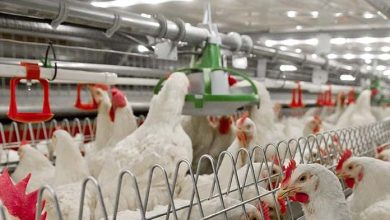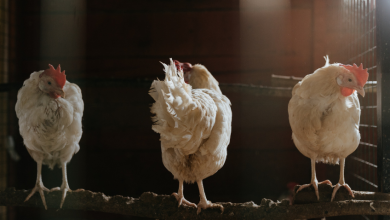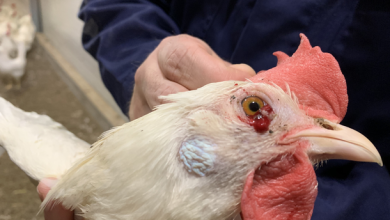Necropsy findings in major poultry diseases

P. S. Mishra1, S. M. Nanda2, S. Satapathy3* and S. K. Joshi4
1Department of Veterinary Pathology, 2Department of Veterinary and Animal Husbandry Extension, 3Department of Anatomy and Histology, CVSc. and A.H., OUAT, Bhubaneswar-751003, Odisha
4Scientist (Animal Science), KVK, Jharsuguda, OUAT, Bhubaneswar-751003, Odisha
Introduction
Post mortem inspection covers the inspection of the carcasses and parts of meat and poultry used for human food. It takes place after the poultry has been slaughtered or dies due to any infection. Thus, the term ‘post mortem’, which means ‘after death’ in Latin is used. The purpose of post mortem inspection is to protect the public health by ensuring that the carcasses and parts that enter commerce are wholesome, not adulterated, properly marked, labelled and packaged. It is also a very important diagnostic tool that is used to support other procedures performed in the diagnosis of disease conditions in birds. There are several other reasons for performing post mortem examination which includes finding the cause of death, confirming a diagnosis, investigating unsuccessful therapy, increasing knowledge or satisfying curiosity. Necropsy procedures are performed in a systematic manner. This is performed at regular basis in organized poultry farms to check the mortality rate. The procedures include collection of history, external examination and preparation of carcass, opening the body cavities, examination of organs and finally the carcass should be well disposed after proper examination to avoid spread of disease to human and animals.
Post mortem findings in different diseases in poultry birds
Infectious bursal disease
It is an acute, highly infectious lymphocidal disease of young, sexually immature chickens caused by virus belonging to Birnaviridae family. In post mortem, we notice haemorrhagic and atrophied bursa with presence of white caseated material in the lumen of bursa, haemorrhages in thigh and pectoral muscle, haemorrhages at the junction between proventriculus and gizzard. Kidneys appear swollen and pale with accumulation of urates in tubules; liver appears pale and bile stained with necrotic foci.
Avian influenza
It is caused by influenza virus belonging to family orthomyxoviridae. Post mortem findings include subcutaneous edema of head and neck; inflammation of sinuses, trachea, air sacs and conjunctiva; congestion of musculature and dehydration, haemorrhagic tracheitis, petechial haemorrhages in proventriculus- gizzard junction. Kidneys are observed to be severely congested with distended ureters, pinpoint haemorrhages in muscles, abdominal fat, peritoneal surfaces of proventriculus and gizzard, pericardium and ovarian follicle, necrotic foci on spleen, haemorrhagic caecal tonsils, and peritonitis with ruptured yolk material.
Marek’s disease
Marek’s disease is a lymphomatous disease of domestic chicken, caused by herpes virus. In the nervous form there are no gross lesions. However, lesions on nerves are only visible under microscope. In viscerous form, greyish white tumours are found in the ovaries, liver, spleen, kidney, heart and other organs. Lesions in the eye appear as loss of pigmentation of iris due to infiltrating lymphocytes with irregular pupil causing blindness called ‘grey eye’.
New castle disease
It is an acute contagious disease of domestic chickens caused by Type 1 Avian Paramyxovirus. Post mortem lesions include haemorrhagic ulcers on the mucosal lining of intestines, pinpoint haemorrhages on the tips of proventricular glands, haemorrhagic caecal tonsils, congestion and haemorrhages in trachea, air sacculitis, egg peritonitis among layers and marked congestion of pectoral muscles.
Fowl cholera
It is one of the most virulent and highly septicemis disease caused by Pasteurella multocida. Lesions seen in per-acute and acute cases include marked congestion of the carcass, multiple petechiation throughout viscera, multiple pin point necrotic foci in the liver. Presence of free yolk in body cavity, edema of lungs, pneumonia and perihepatitis are observed in layer birds. In chronic form we see caseous arthritis of hock joints, swelling and induration of one or both wattles, caseous exudates in the middle ear.
Pullorum disease
This disease mostly affects young chicks and is caused by Salmonella pullorum. Post mortem findings include unabsorbed yolk sac, peritonitis, congested lungs, dark, swollen and haemorrhagic liver and typhlitis. In growers, arthritis of hock joint is seen with the presence of lemon or orange coloured gelatinous material. In adults, abnormal ovary with ova, peritonitis, arthritis and pericarditis are seen.
Fowl typhoid
This is also known as Infectious Enteritis and is caused by Salmonella gallinarum. In acute phase, we see lesions like septicaemic and jaundiced appearance, congested skeletal muscles; swollen, friable and dark red liver with coppery bronze sheen surface, enlarged spleen, catarrhal enteritis, characteristic dark brown bone marrow. In chronic phase, emaciation, anaemia, focal necrosis in heart, intestine, pancreas and liver are seen. Greyish white necrotic foci seen in the myocardium, mucosa of intestine and pancreas, pericarditis with morbid yellow fluid in the pericardial sac, retained yolk which may subsequently rupture in layers.
Colibacillosis
It is caused by Escherichia coli. Post mortem findings include air sacculitis, perihepatitis, pericarditis, and peritonitis. Liver, spleen, lungs and kidneys are dark and congested; air sacs are thickened, opaque and white. Fibrinous pericarditis with thickened pericardial sac adhering to surface of the heart is a characteristic feature of this disease. The surface of the liver is also covered with gelatinous, greyish fibrinous material.
Aspergillosis
It is also known as Brooders Pneumonia or Pneumomycosis caused by Aspergillus fumigatus. In post mortem, presence of small, white caseous nodules measuring approximately 1 mm in diameter are seen scattered throughout the lung tissue and also air sacs. Lesions in brain tissue appear as white to yellow circumscribed areas.
Candidiasis
This is also known as Moniliasis or Thrush. It is caused by Candida albicans. Lesions are common in crop and to lesser extent or frequency in mouth, oesophagus and proventriculus. In acute cases, crop lining will be thickened and opaque. In chronic cases, the crop reveals raised white patches of ulceration and still in most severe case, there will be turkish towel appearance of crop with thickening. Mouth, oesophagus and proventriculus reveal ulceration and inflammation.
Coccidiosis
It is an expensive and very common disease of poultry that cause significant economic loss with universal importance and is caused by a protozoan parasite belonging to genus Eimeria. Lesions are mostly seen in intestinal tract in the form of haemorrhages and massive swellings. Serous surfaces reveal white focal lesions and haemorrhagic spots. Intestinal contents consist of blood and mucus mixed with necrotic material which is described as gruel like mass.
Conclusion
Population growth, urbanization and the rise of income has increased the demand for animal protein at an exponential rate. The commercial poultry population has increased by 4.5% over the previous census and backyard poultry has increased by 45.8%. An increase of 16.8% has been observed in the total poultry population of the country. Thus, we must provide quality treatment to the poultry farmers and stakeholders in order to popularize poultry farming in India. This can serve as a revolution to cater the protein needs of the citizens. Post mortem examination helps in proper diagnosis of disease and in control of death in case of outbreaks and further treatment and prevention.



